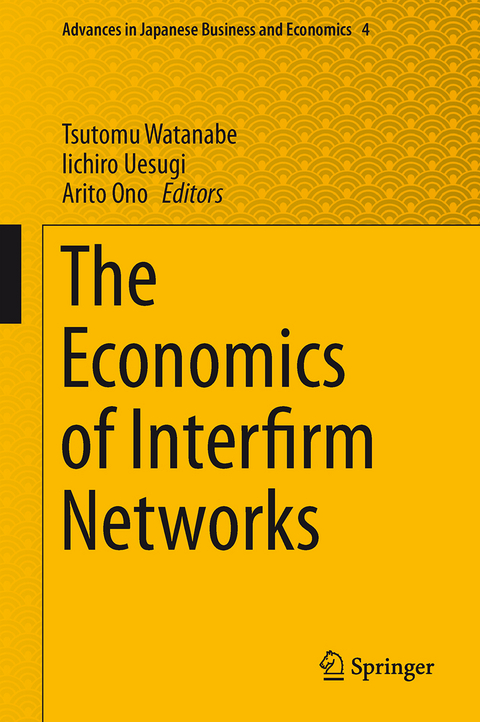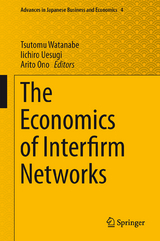The Economics of Interfirm Networks
Networks prevail in many aspects of economic activities and play a major role in explaining a wide variety of economic phenomena from business cycles to knowledge spillovers, which has motivated economists to produce a number of excellent works. In the policy arena, there has been a growing concern on the vulnerabilities of networks based on the casual observation that idiosyncratic shocks on firms can be amplified through inter-firm connections and leads to a systemic crisis. Typical examples are the manufacturing supply-chain networks in the automobile and electronics industries which propagated regionally concentrated shocks (the Great East Japan Earthquake and floods in Thailand in 2011) into global ones. An abundance of theoretical literature on the formation and functions of networks is available already.
This book breaks new ground, however, and provides an excellent opportunity for the reader to gain a more integrated understanding of the role of networks in the economy. The Economics of Interfirm Networks will be of special interest to economists and practitioners seeking empirical and quantitative knowledgeon interfirm and firm–bank networks.
Tsutomu Watanabe has been a professor of economics at the Graduate School of Economics, The University of Tokyo, since October 2011. He has also been a professor at Hitotsubashi University (1999–2011) and a senior economist at the Bank of Japan (1982–1999). He has held visiting positions at various universities, including Kyoto University, Bocconi University, and Columbia University. He received his Ph.D. in economics from Harvard University in 1992 and did his undergraduate work at The University of Tokyo. Watanabe’s main research area is monetary policy and inflation dynamics. He is known for his series of papers on monetary policy when nominal interest rates are bounded at zero; in particular, his paper on the optimal monetary policy at the zero lower bound, whose first draft appeared in 2001 and final version was published in 2005, has been widely recognized as the first paper to provide a simple description of the liquidity trap and characterize the optimal policy response to it in a setting of dynamic stochastic general equilibrium. He is an author of many books and more than 40 academic journal articles on monetary policy and international finance. Iichiro Uesugi is an associate professor at the Institute of Economic Research of Hitotsubashi University, Japan. He received his M.A. and Ph.D. in economics in 2000 from the University of California, San Diego. Prior to becoming a member of the faculty of Hitotsubashi University in 2011, he joined the Ministry of Economy, Trade and Industry (METI) in 1993 and worked in the Economic Policy Unit of the Minister's Secretariat, Macroeconomic Affairs Division; the Planning Division of the Coal Department in the Agency of Natural Resources and Energy; the Research Division of the Small and Medium Enterprises Agency; and the Research Institute of Economy, Trade and Industry. His research interests focus on firm dynamics,financial intermediation, and the Japanese economy. His research has been published in a number of scholarly journals including the Journal of Money, Credit, and Banking, the Journal of Banking & Finance, and the Journal of the Japanese and International Economies. Arito Ono is a professor at the Department of Banking and Corporate Finance, Faculty of Commerce, Chuo University, Japan. Prior to joining Chuo University in 2015, he was a senior economist at the Mizuho Research Institute, and a senior economist at the Institute for Monetary and Economic Studies, Bank of Japan (2009–2011). He has also been a member of several working groups at the Financial System Council, Financial Services Agency (2011–2015). His main fields of research are banking and corporate finance, and he has published papers in the Journal of Money, Credit, and Banking, the Journal of Banking & Finance, and the Journal of Financial Stability, among others. He received a B.A. in economics from the University of Tokyo and a Ph.D. in economics from Brown University.
Chapter 1 The Economics of Interfirm Networks: Main Issues.- Part 1: Structure and Evolution of Interfirm Networks.- Chapter 2 Buyer-Supplier Networks and Aggregate Volatility.- Chapter 3 Community Structure of a Large-scale Production Network in Japan.- Chapter 4 Interfirm Networks in Manufacturing Industry Agglomerations in Japan: Evidence from Survey Data.- Part 2: Networks, Economic Geography, and Firm Activities.- Chapter 5 Economic Geography and Interfirm Transaction Networks.- Chapter 6 Delineating Metropolitan Areas: Measuring Spatial Labour Market Networks through Commuting Patterns.- Chapter 7 Determinants of Business and Financial Network Formation by Japanese Start-up Firms: Does Founders' Human Capital Matter?.- Chapter 8 Geographical Spread of Interfirm Transaction Networks and the Great East Japan Earthquake.- Part 3: Bank-Firm Relationships and Firm Dynamics.- Chapter 9 Bank-Firm Relationships: A Review of the Implications for Firms and Banks in Normal and Crisis Times.- Chapter 10 A New Look at Bank-Firm Relationships and the Use of Collateral in Japan: Evidence from Teikoku Databank Data.- Chapter 11 What Do Cash Holdings Tell Us about Bank-Firm Relationship? A Case Study of Japanese Firms.- Chapter 12 Bank Lending and Firm Activities: Overcoming Identification Problems.
| Reihe/Serie | Advances in Japanese Business and Economics ; 4 |
|---|---|
| Zusatzinfo | 14 Illustrations, color; 31 Illustrations, black and white; X, 263 p. 45 illus., 14 illus. in color. |
| Verlagsort | Tokyo |
| Sprache | englisch |
| Maße | 155 x 235 mm |
| Themenwelt | Mathematik / Informatik ► Informatik ► Theorie / Studium |
| Sozialwissenschaften ► Soziologie | |
| Wirtschaft ► Betriebswirtschaft / Management ► Finanzierung | |
| Wirtschaft ► Volkswirtschaftslehre ► Mikroökonomie | |
| Schlagworte | Economic Geography • Firm–bank relationships • Firm dynamics • Macroeconomic activities • Network |
| ISBN-10 | 4-431-55389-4 / 4431553894 |
| ISBN-13 | 978-4-431-55389-2 / 9784431553892 |
| Zustand | Neuware |
| Haben Sie eine Frage zum Produkt? |
aus dem Bereich




